Key takeaways:
- Student union petitions empower students to address issues and advocate for change, fostering a sense of community and shared purpose.
- Engaging fellow students in the petition process strengthens collective voices and encourages broader participation.
- Creating an effective petition involves identifying a relevant issue, articulating a clear message, and employing various strategies to gather support.
- Personal experiences and storytelling enhance the emotional impact of petitions, making them relatable and compelling to others.

Understanding student union petitions
Student union petitions serve as a powerful tool for students to voice their concerns and advocate for change within their university. I still remember when I filed my first petition; it was exhilarating to feel like my voice mattered among the sea of students. Have you ever felt frustrated about something on campus? That’s exactly how I felt, and I realized that creating a petition could channel that energy into something constructive.
The process of starting a petition often begins with identifying a specific issue that resonates with a significant number of students. For me, it was the lack of mental health resources available on campus. It was striking to see my peers rally around a common cause, sharing their stories and experiences. Isn’t it amazing how a simple idea can bring people together to advocate for change?
Once a petition captures the interest of the student body, the next crucial step is gathering signatures. I found this aspect both challenging and rewarding; it pushed me to engage with fellow students, hear their perspectives, and strengthen our collective voice. In those discussions, I often wondered—what other issues, big or small, could be addressed if more students felt empowered to speak out?
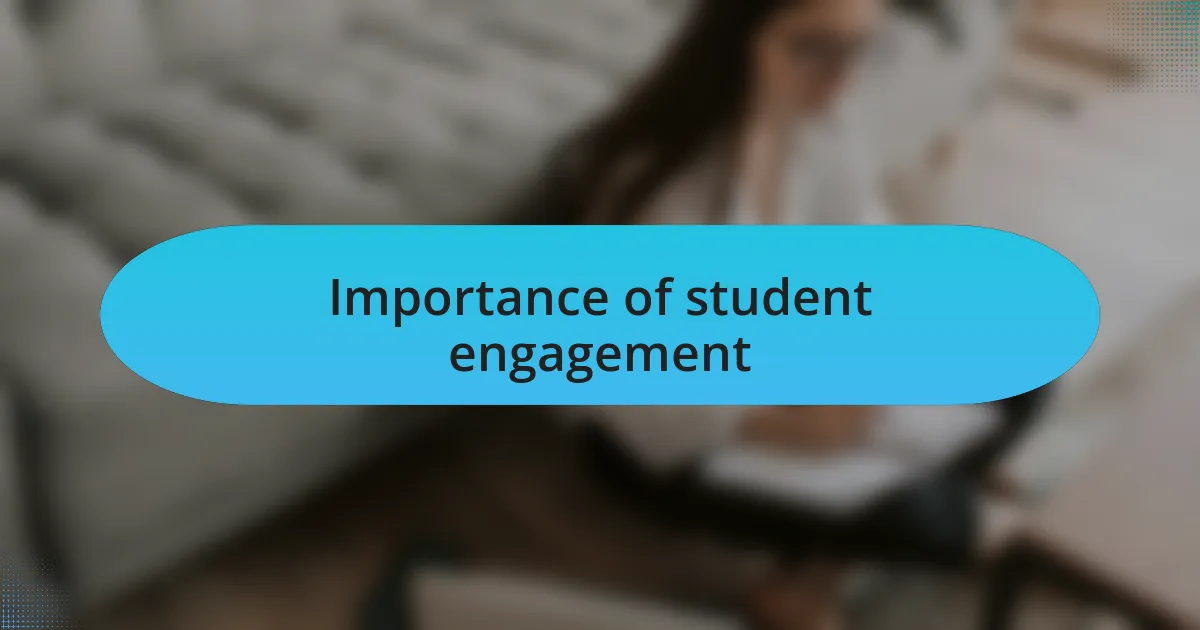
Importance of student engagement
Student engagement is vital in fostering a vibrant university community. When students actively participate, they transform their campus experience into one that reflects their values and needs. I recall the energy of a town hall meeting where students passionately discussed their concerns; it felt less like a formal gathering and more like a powerful movement. Can you imagine the impact when numerous voices come together, echoing the same sentiments?
The beauty of engagement lies in its ripple effect. Each person who steps forward inspires another to do the same, creating a chain reaction of involvement and support. I’ve experienced this firsthand while collaborating with peers to address dining options on campus. Once we started discussing meal variety, it opened up avenues for others to share their experiences, reinforcing that we weren’t alone in our frustrations. Isn’t it uplifting to see change become a collective effort?
Moreover, student engagement cultivates a sense of ownership over the university experience. When students feel connected and invested, they’re more likely to advocate for initiatives that align with their aspirations. I remember feeling a sense of pride when our petition led to new sustainability efforts on campus. It made me wonder—what else could we achieve if every student felt empowered to engage actively, not just as isolated voices, but as part of a powerful, united front?
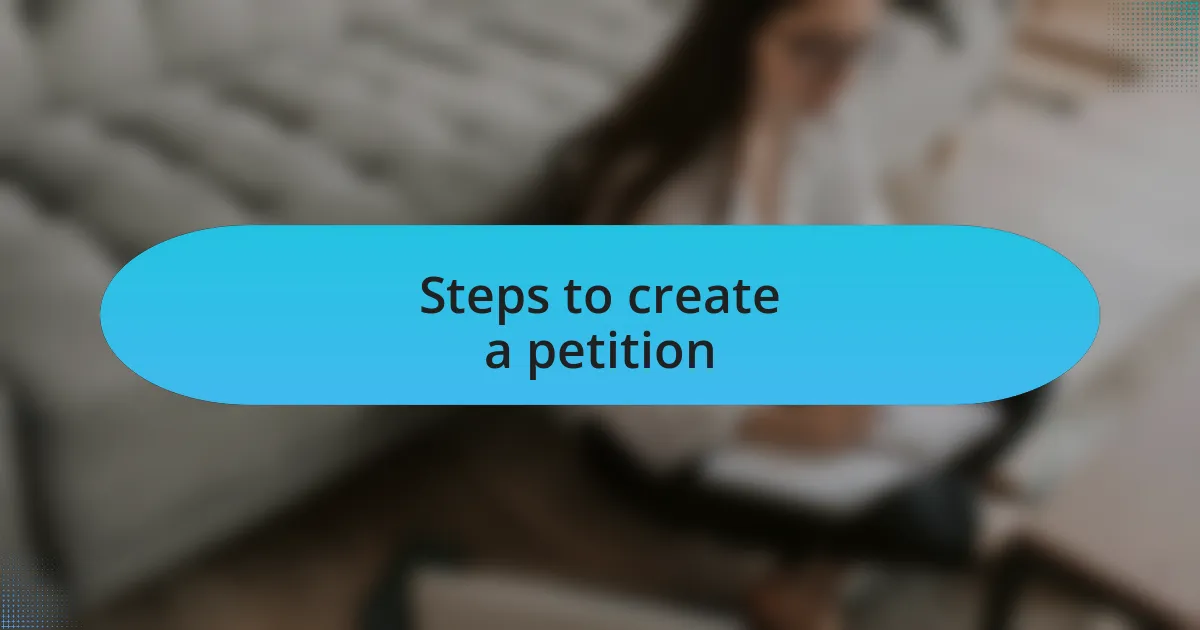
Steps to create a petition
Creating a petition starts with identifying a specific issue that resonates with you and your peers. I remember sitting down with friends, brainstorming what mattered most on our campus. It wasn’t just about complaining; it was about pinpointing what change we wanted to see. Have you thought about what issue could spark the same passion within your community?
Once you’ve identified the issue, the next step is to clearly articulate your message. This involves writing a concise statement that outlines your goal. I found that using straightforward, passionate language helped convey our urgency. We focused on how the change would benefit the wider student body, not just our group. How can your message inspire others to join the cause?
After crafting a compelling statement, it’s crucial to gather signatures. Reaching out to fellow students, whether in class or at events, builds momentum. I experienced the thrill of seeing people sign our petition, fueled by a shared vision for change. It was empowering, knowing that each signature represented a voice willing to stand alongside us. What strategies will you employ to motivate others to lend their support?
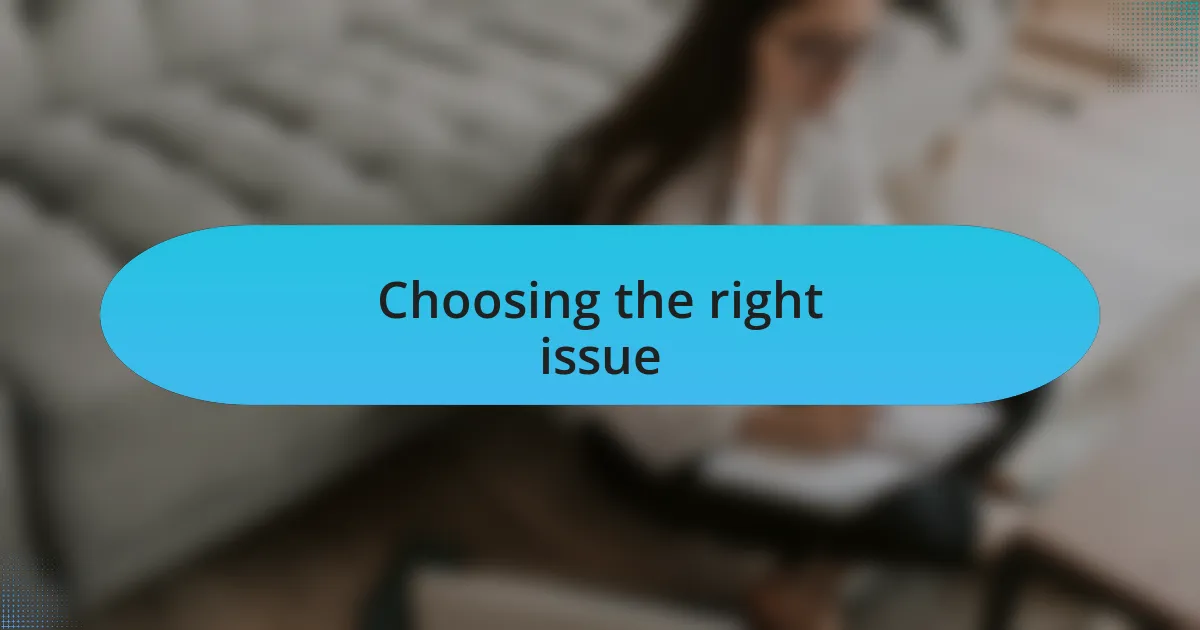
Choosing the right issue
Choosing the right issue involves more than simply selecting a topic; it’s about finding something that ignites a passion within you and resonates deeply with your community. I recall when I stumbled across a significant concern related to mental health resources on campus. It struck me that so many students shared this struggle, making it not only personal but also a collective issue that demanded attention. Have you ever felt that kind of urgency about an issue?
Listening to the voices of fellow students can help identify the right issue to champion. During conversations with my peers, I learned about the widespread discontent with the quality of study spaces. Their frustrations mirrored my own, and the drive to improve our environment became a unifying force. What common challenges do you hear about, and how can they shape your petition’s focus?
Additionally, reflecting on issues that have sparked previous movements can provide insights into what resonates. During my time at university, I witnessed powerful petitions that tackled everything from sustainability initiatives to inclusivity policies. Each one began with someone daring to articulate a shared concern that resonated with a wide audience. How can you draw inspiration from past movements to fuel your passion and clarify your goal?
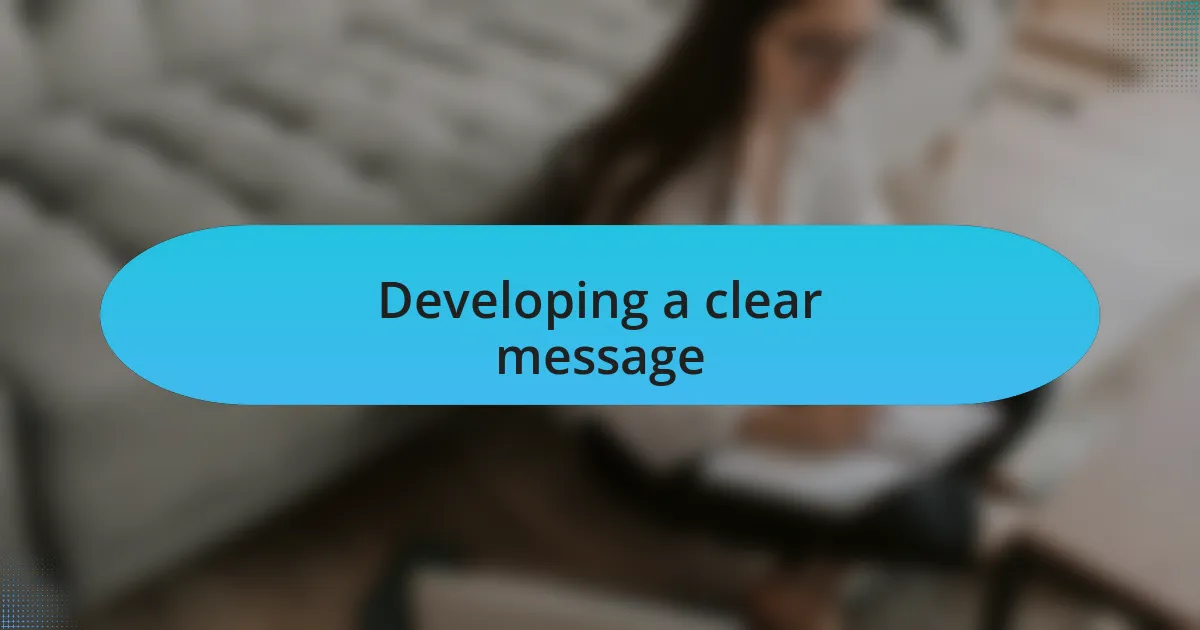
Developing a clear message
When developing a clear message for your petition, it’s essential to distill your thoughts into a few powerful statements. I remember a time when I was crafting my own message about improving campus safety. I spent hours narrowing down my main point until it echoed what students truly needed. What’s the core idea that drives your cause?
A clear message should resonate emotionally with your audience. During my journey, I found that sharing personal stories was incredibly impactful. For instance, I spoke about a friend who faced a safety incident on campus, which brought our issue to life and made it relatable. How can your experiences evoke an emotional response in others?
Moreover, simplicity is critical. I learned that less is often more when it comes to messaging. By focusing on a concise slogan that encapsulated our goal—”Safe Spaces for All”—we caught everyone’s attention. Have you tested your message with friends to see if it resonates? Their feedback could be invaluable in refining your approach.
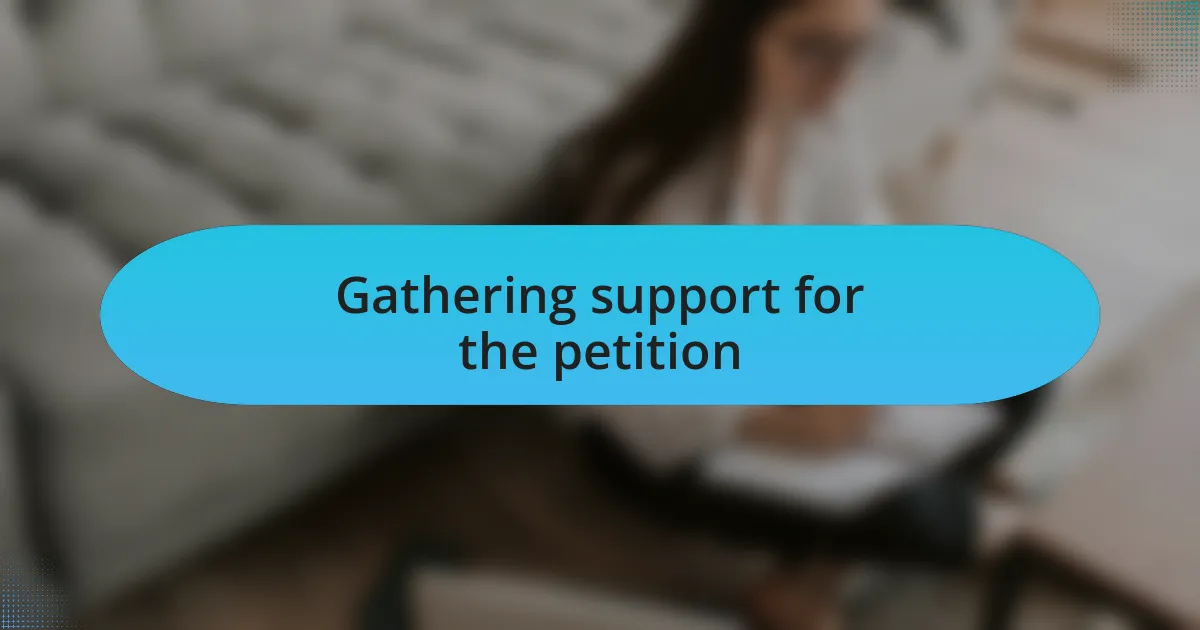
Gathering support for the petition
To gather support for your petition, reaching out to your peers is crucial. I vividly recall standing in the student center with a clipboard, asking fellow students to sign my petition. Their reactions were mixed, but when I shared my passion and personal connection to the cause, many agreed to join. Have you thought about where to find your most enthusiastic supporters?
Harnessing social media can amplify your efforts significantly. When I created a dedicated page for my petition, I posted updates and shared stories about our cause daily. I was surprised by how quickly friends and even strangers rallied around it, inspiring much-needed conversations. How are you using your social platforms to engage your audience effectively?
Finally, organizing events or gatherings can create a sense of community around your petition. I once hosted a small meet-up where like-minded individuals came together to discuss our goals. It was amazing to see how the collective energy inspired new ideas and bolstered our sense of urgency. Could hosting an event be your next step in building momentum?
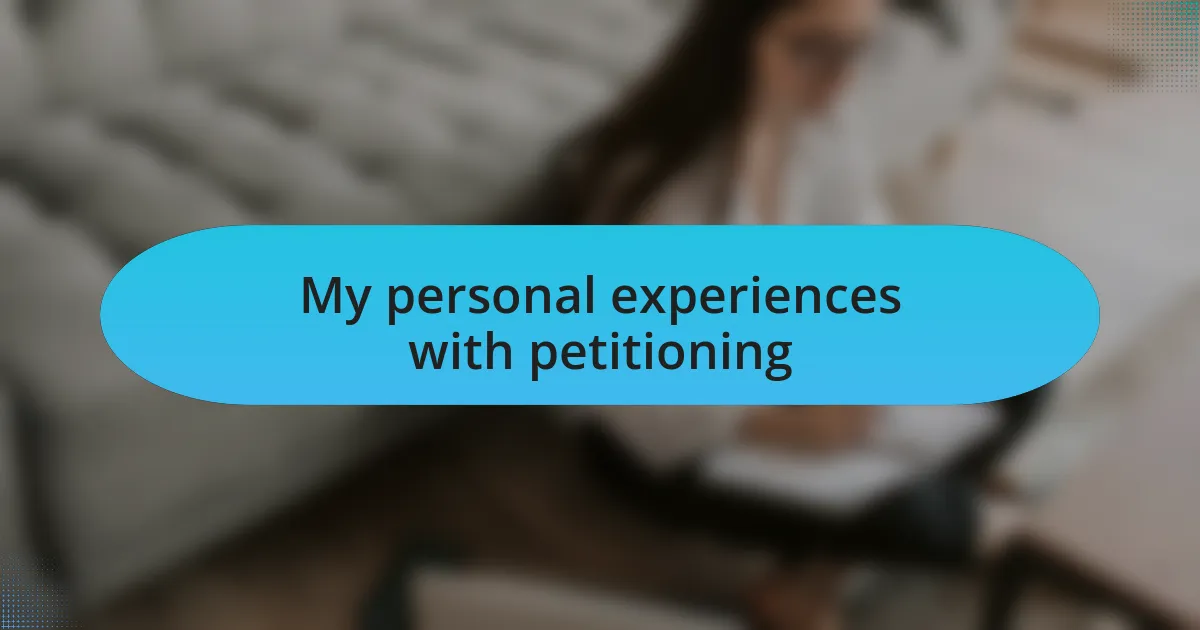
My personal experiences with petitioning
I remember the first time I drafted a petition. The words flowed easily, fueled by my passion for the cause. That feeling of empowerment, knowing I could advocate for something I truly believed in, is a memory I cherish. Have you ever felt that surge of determination when you set out to make a change?
There were moments when doubt crept in. I faced criticism from a few fellow students who questioned the impact of my efforts. Instead of letting it discourage me, I used their skepticism as fuel to refine my arguments and present a stronger case. I realized that even challenges can become stepping stones in the journey. Have you considered how criticism can help you grow?
One particularly memorable experience was presenting my petition during a student assembly. As I spoke, I could feel the energy in the room shift. Seeing heads nod in agreement reminded me why I started this journey. It was a powerful moment, reinforcing my belief in collective action. Have you thought about how sharing your passion publicly could spark similar connections?